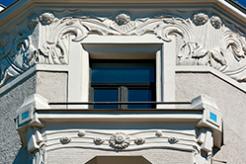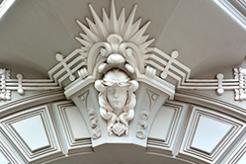




Author: Agrita Tipāne, Dr. arch.
Art Nouveau was a new artistic and aesthetic system that emerged in the late 19th and early 20th centuries, which became the first modern style in Latvia. In Riga this style was most pronounced in architecture, with the first Art Nouveau (or Jugendstil) buildings erected in the context of developing trade and industry and rapid economic growth. On average between 150 and 200 buildings were completed every year in Riga, mostly multi-storey masonry apartment blocks. These reflected the superficially grandiose social ideals of the age, with richly decorated facades, pompous stairwells and lavish apartments. At the same time, the inhabitants of the early 20th century had begun learning the principles of ecology and gave high priority to a healthy lifestyle. New urban planning principles necessitated the greening of the city and creating a humane living space for its residents. Parks and gardens were established between the residential quarters, and the streetscapes were landscaped. One of the clearest examples of this trend was Alberta iela. Construction of this new street began in 1901, with planning regulations stipulating that lawns be planted on one side. Often ecological ideas were also applied inside the apartments, with large numbers of potted plants to improve the microclimate. Furthermore, alongside the parks and plants, nature also entered the city through artistic interpretation. Artists frequently sought inspiration from nature and its elements, resulting in ornamental Art Nouveau décor. As noted by Professor Jānis Krastiņš, “while the essence of a style is not determined by ornamental décor, Art Nouveau structures are often decorated at the level of artistic synthesis with ornaments in the unique language of this style.”
The Art Nouveau period saw the development of branches of science which intensively studied the natural world, increasing human understanding of the environment. Artists and writers also sought inspiration in nature, celebrating it in poetry and prose, paintings and sculptures. In the early 20th century, outstanding Latvian painters including Vilhelms Purvītis (1872–1945), Janis Rozentāls (1866–1916) and Jānis Valters (1869–1932) revealed the beauty of Latvia’s nature in their works.
The greatest reflection of nature and its elements was in Riga’s Art Nouveau architecture. This was an expression of a desire to shed previous historic styles and create a unique artistic world with appropriate symbolism. This was most apparent in the volumes and facades of the buildings, and also in their interiors. The buildings had complex compositions, often resembling fairy tale castles or fortresses, while their silhouettes were dominated by towers bearing fanciful weathervanes and elements of fauna. Their facades were planned asymmetrically, thus accenting bays, balconies and pediments. These architectural elements were often richly decorated with mouldings depicting various natural elements.
More information will be available in the virtual exhibition, which will be established till April 2016.